- Essential tips for growing large-leaved hydrangea outdoors
- 1. Choose the right location
- 2. Provide adequate watering
- 3. Mulch for moisture retention
- 4. Prune at the right time
- 5. Fertilize responsibly
- 6. Protect from winter frost
- 7. Monitor for pests and diseases
- 8. Consider pH for color change
- Choosing the right location
- Preparing the soil
- Providing proper sunlight
- Watering and fertilizing
- Pruning and deadheading
- 1. Pruning
- 2. Deadheading
- Protecting against pests and diseases
- 1. Regularly inspect the plant
- 2. Prune infected parts
- 3. Provide adequate spacing
- 4. Use organic pest control methods
- 5. Use disease-resistant varieties
- 6. Provide proper watering and fertilization
- 7. Mulch around the base
- 8. Clean gardening tools
- Ensuring its survival during winter
- 1. Provide winter protection
- 2. Avoid pruning in late summer or fall
- 3. Consider using a frost cover
- 4. Water sparingly
- 5. Monitor for signs of stress
- Harvesting and drying the blooms
- Questions and Answers:
- What are some essential tips for growing large-leaved hydrangea outdoors?
- How much sunlight does a large-leaved hydrangea need?
- What is the best way to water a large-leaved hydrangea?
- When should I fertilize a large-leaved hydrangea?
- How can I ensure the survival of a large-leaved hydrangea during winter?
- Can I grow a large-leaved hydrangea in a container?
- Videos: Beginner’s Guide to Hydrangea Care | Lazy Gardener’s Guide to Hydrangeas
Growing large-leaved hydrangea outdoors can be a rewarding and visually stunning addition to any garden. With their vibrant blooms and lush foliage, these plants are a true showstopper. However, it is important to understand the specific care requirements of large-leaved hydrangeas in order to ensure their survival, especially during the harsh winter months. In this article, we will provide you with some essential tips to help you grow and protect your large-leaved hydrangea.
1. Choosing the right location: Large-leaved hydrangeas thrive in a spot with partial shade, ideally receiving morning sun and afternoon shade. Avoid planting them in areas with full sun, as this can cause the leaves to wilt and the blooms to fade quickly.
2. Soil preparation: Large-leaved hydrangeas prefer moist, well-drained soil with a slightly acidic pH. Before planting, amend the soil with organic matter, such as compost or peat moss, to improve its fertility and drainage. This will provide a nourishing environment for the roots to establish and grow.
3. Watering: Hydrangeas have shallow roots, so regular watering is crucial, especially during hot, dry weather. Avoid overwatering, as this can lead to root rot. Instead, water deeply and allow the soil to dry out slightly between waterings. Mulching around the base of the plant will help retain moisture and regulate soil temperature.
4. Pruning: Large-leaved hydrangeas bloom on old wood, so it is important to prune them immediately after they finish flowering. Remove any dead or damaged wood, as well as any weak or crossing branches. This will encourage new growth and ensure a healthier, more vigorous plant.
5. Winter protection: Winter can be particularly harsh for large-leaved hydrangeas. To protect the plant from frost damage, consider wrapping it with burlap or a frost blanket and adding a layer of mulch around the base. It is also advisable to cover the plant during extremely cold nights or heavy snowfall. This will help insulate the plant and prevent the branches from breaking due to the weight of the snow.
By following these essential tips, you can successfully grow large-leaved hydrangeas outdoors and ensure their survival during winter. With proper care and attention, these stunning plants will continue to grace your garden with their beautiful blooms for years to come.
Essential tips for growing large-leaved hydrangea outdoors
1. Choose the right location
Large-leaved hydrangeas thrive in partially shaded areas with moist, well-drained soil. Choose a spot in your garden that receives morning sun and afternoon shade. Avoid planting them in areas with full sun, as it can cause the leaves to burn.
2. Provide adequate watering
Hydrangeas require regular watering, especially during hot and dry periods. Keep the soil consistently moist, but not waterlogged. Water deeply at the base of the plant to encourage deep root growth.
3. Mulch for moisture retention
Apply a layer of mulch around the base of the hydrangea to help retain moisture and regulate soil temperature. Mulch also helps suppress weed growth and adds nutrients to the soil as it breaks down.
4. Prune at the right time
Pruning large-leaved hydrangeas should be done in late winter or early spring, before new growth appears. Remove any dead or damaged branches, as well as any weak or crossing branches. Pruning helps promote better air circulation and improves overall plant health.
5. Fertilize responsibly
Hydrangeas benefit from regular fertilization during the growing season. Use a balanced slow-release fertilizer or a granular fertilizer formulated specifically for hydrangeas. Follow the manufacturer’s instructions for application rates and timing.
6. Protect from winter frost
In colder regions, large-leaved hydrangeas are susceptible to frost damage. Before winter arrives, wrap the plant with burlap or cover it with a frost blanket to provide insulation and protect it from freezing temperatures. Remove the cover in early spring.
7. Monitor for pests and diseases
Keep an eye out for common hydrangea pests, such as aphids, spider mites, and powdery mildew. Regularly inspect the leaves and stems for any signs of damage or discoloration. Treat any infestations or infections promptly with appropriate insecticides or fungicides.
8. Consider pH for color change
Large-leaved hydrangeas can change color based on the soil pH. Acidic soil (pH below 6) produces blue flowers, while alkaline soil (pH above 6) produces pink flowers. If you prefer a specific color, you can amend the soil accordingly or use additives specifically designed to adjust pH levels.
- Choose a partially shaded location with moist, well-drained soil.
- Water regularly, keeping the soil consistently moist.
- Apply mulch to retain moisture and regulate soil temperature.
- Prune in late winter or early spring to promote better air circulation.
- Fertilize with a balanced slow-release or granular hydrangea fertilizer.
- Protect from winter frost with burlap or a frost blanket.
- Monitor for pests and diseases and treat as necessary.
- Consider adjusting soil pH for desired flower color.
Choosing the right location
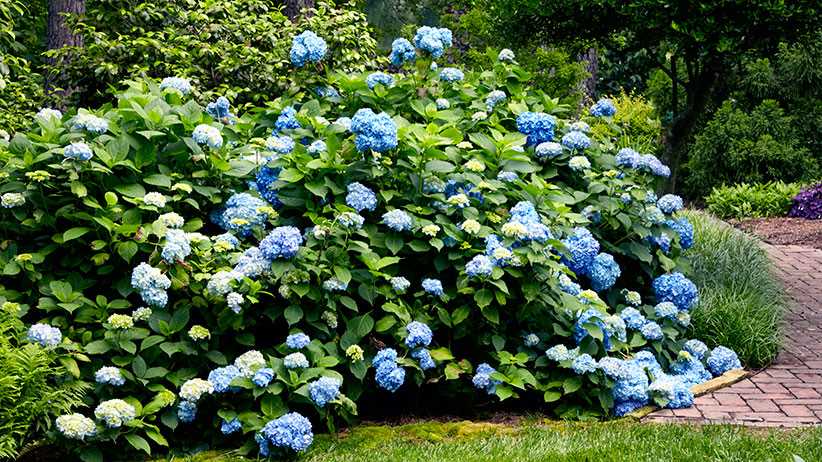
When it comes to growing large-leaved hydrangeas outdoors, choosing the right location is crucial for their healthy development. Here are some key factors to consider when selecting a location:
- Sunlight: Large-leaved hydrangeas thrive when they receive ample sunlight, but they also appreciate some shade during the hottest part of the day. Ideally, choose a location that offers morning sun and afternoon shade.
- Soil quality: Hydrangeas prefer well-draining, fertile soil that is rich in organic matter. Before planting, amend the soil with compost or peat moss to improve its texture and nutrient content.
Moisture: Hydrangeas need consistent moisture to thrive, but they don’t like to sit in waterlogged soil. Choose a location with good drainage to prevent waterlogging. Protection from strong winds: Large-leaved hydrangeas have delicate leaves and branches that can be easily damaged by strong winds. Plant them in a location that is sheltered from strong gusts to prevent breakage.
By selecting the right location for your large-leaved hydrangeas, you can ensure that they receive the ideal amount of sunlight, proper drainage, and protection from harsh weather conditions. This will create the perfect environment for their growth and survival during winter.
Preparing the soil
Before planting a large-leaved hydrangea in your garden, it’s important to prepare the soil to ensure optimal growth and survival. Here are some essential steps to follow:
- Test the soil pH: Hydrangeas prefer acidic soil with a pH level between 5.2 and 5.5. Use a soil testing kit to determine the pH of your soil. If the pH is too high, you may need to lower it by adding sulfur or aluminum sulfate.
- Improve soil drainage: Hydrangeas do not thrive in waterlogged soil. If your soil has poor drainage, amend it by mixing in organic matter such as compost or well-rotted manure. This will help improve soil structure and drainage.
- Remove weeds and rocks: Before planting, clear the area of any weeds, rocks, or debris. Hydrangeas have shallow roots, and weed competition can hinder their growth.
- Amend the soil with nutrients: Hydrangeas benefit from nutrient-rich soil. Add balanced fertilizer or compost to provide essential nutrients. Follow the instructions on the fertilizer package for the correct application rates.
- Loosen the soil: Use a garden fork or tiller to loosen the soil in the planting area. This will improve aeration and allow the roots to establish more easily.
By following these steps, you can create a favorable environment for your large-leaved hydrangea to thrive and ensure its survival during the winter months.
Providing proper sunlight
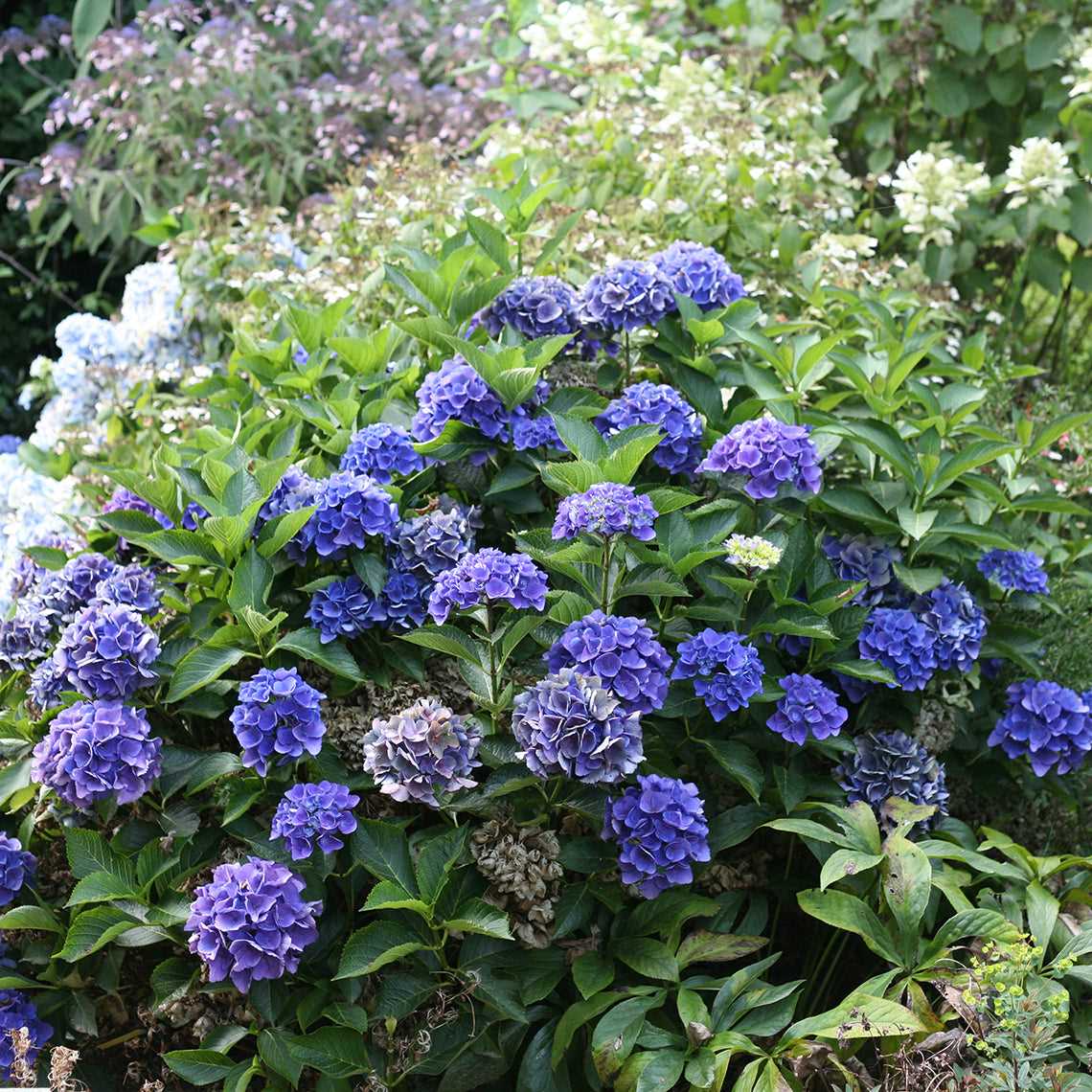
Growing large-leaved hydrangeas outdoors requires providing them with the proper amount of sunlight. The amount of sunlight hydrangeas need depends on the specific variety, but generally, they thrive in partially shaded areas. Here are some tips for providing the right amount of sunlight:
- Site selection: Choose a location that receives partial shade, ideally with morning sun and afternoon shade, to protect the hydrangeas from intense sunlight.
- Filtered light: If your garden only has full sun areas, consider planting the hydrangeas near tall trees or shrubs that can provide filtered light during the hottest part of the day.
- Avoiding direct sunlight: Hydrangeas are sensitive to intense sunlight, especially during hot summer days. Position them where they will be shielded from direct sunlight, particularly during the afternoon hours.
- Keep an eye on the leaves: If the leaves start to wilt or turn brown, it may be an indication that the hydrangeas are receiving too much sunlight. Consider moving them to a more shaded area.
- Monitor sunlight levels: If you are unsure about the amount of sunlight reaching your hydrangeas, monitor the sunlight levels by using a garden light meter. This will help you determine if the location is suitable for their growth and adjust accordingly.
By providing the proper amount of sunlight, you can ensure that your large-leaved hydrangeas thrive and survive during winter.
Watering and fertilizing
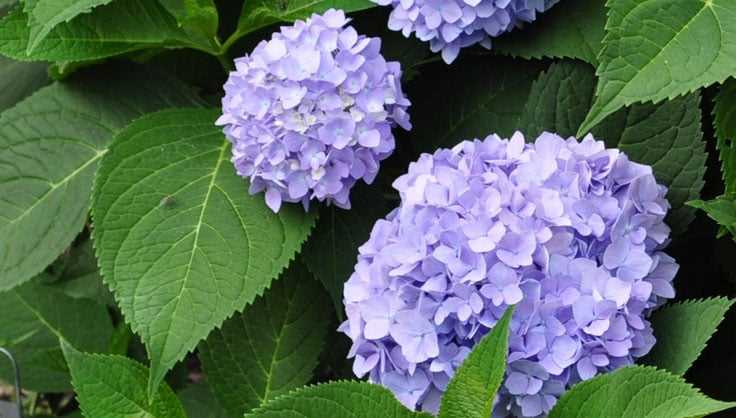
Proper watering and fertilizing are important factors in growing large-leaved hydrangeas successfully outdoors. Here are some tips to help you keep your hydrangeas well-hydrated and nourished:
- Watering: Hydrangeas thrive in moist soil but are susceptible to root rot if over-watered. Water your hydrangeas deeply, at least once a week, especially during dry periods. Use a soaker hose or watering can to water at the base of the plant, avoiding wetting the foliage. This helps prevent diseases and encourages strong root growth.
- Fertilizing: Hydrangeas benefit from regular fertilization to promote healthy growth and abundant blooms. Apply a balanced slow-release fertilizer, formulated for flowering plants, in early spring. Follow the manufacturer’s instructions for the correct dosage and method of application. Avoid fertilizing too late in the season, as this can encourage new growth that may not have time to harden off before winter.
- Organic matter: Incorporating organic matter, such as compost or well-rotted manure, into the soil before planting hydrangeas helps improve soil fertility and water-holding capacity. Additionally, adding a layer of organic mulch around the base of the plant helps retain soil moisture and suppresses weed growth.
- Monitoring: Regularly check the soil moisture level by inserting your finger into the soil. If the top inch feels dry, it’s time to water. Adjust your watering schedule as needed, taking into account the weather conditions and the moisture needs of your specific hydrangea variety.
By following these guidelines for watering and fertilizing, you can ensure that your large-leaved hydrangeas remain healthy and vibrant throughout the growing season.
Pruning and deadheading
Pruning and deadheading are important tasks in maintaining the health and appearance of large-leaved hydrangeas. Here are some essential tips:
1. Pruning
Pruning is recommended to shape and control the growth of the hydrangea plant. It is best to prune large-leaved hydrangeas in late winter or early spring before new growth appears.
To prune, follow these steps:
- Remove any dead or damaged stems by cutting them off at the base.
- Trim back any weak or thin stems to encourage fuller growth.
- Remove old flowers by cutting the stem just above a set of healthy leaves or buds.
- Avoid cutting back more than one-third of the plant’s overall growth.
2. Deadheading
Deadheading is the process of removing spent flowers from the hydrangea plant. Deadheading can help promote new flower growth and keep the plant looking tidy.
To deadhead, follow these steps:
- Wait until the flowers have fully faded and dried on the stem.
- Locate the first pair of healthy leaves below the spent flower.
- Cut the stem just above this pair of leaves, making a clean, angled cut.
- Remove any loose or damaged foliage around the deadheaded flower.
It is important to note that not all hydrangea varieties require deadheading. Some varieties, such as the mophead hydrangea, can benefit from deadheading, while others, such as the panicle hydrangea, do not require it.
Protecting against pests and diseases
Growing large-leaved hydrangea outdoors can make it susceptible to various pests and diseases. Here are some tips on how to protect your plant:
1. Regularly inspect the plant
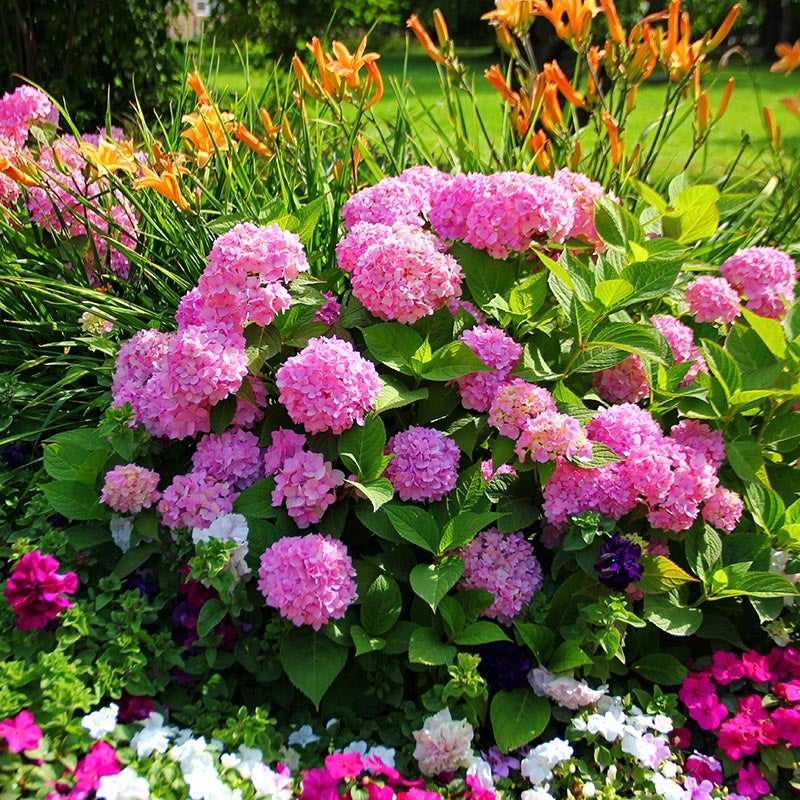
Make it a habit to inspect your hydrangea regularly. Look for any signs of pests or diseases such as yellowing leaves, spots, holes in leaves, or small insects. Early detection can help prevent further damage.
2. Prune infected parts
If you notice any infected parts on your hydrangea, such as diseased leaves or stems, make sure to prune them immediately. Removing infected parts can prevent the spread of diseases and illnesses to other parts of the plant.
3. Provide adequate spacing
Ensure that your hydrangea plants are adequately spaced. Overcrowding can create a favorable environment for pests and diseases to spread. Proper spacing allows for better airflow and reduces the risk of infestation.
4. Use organic pest control methods
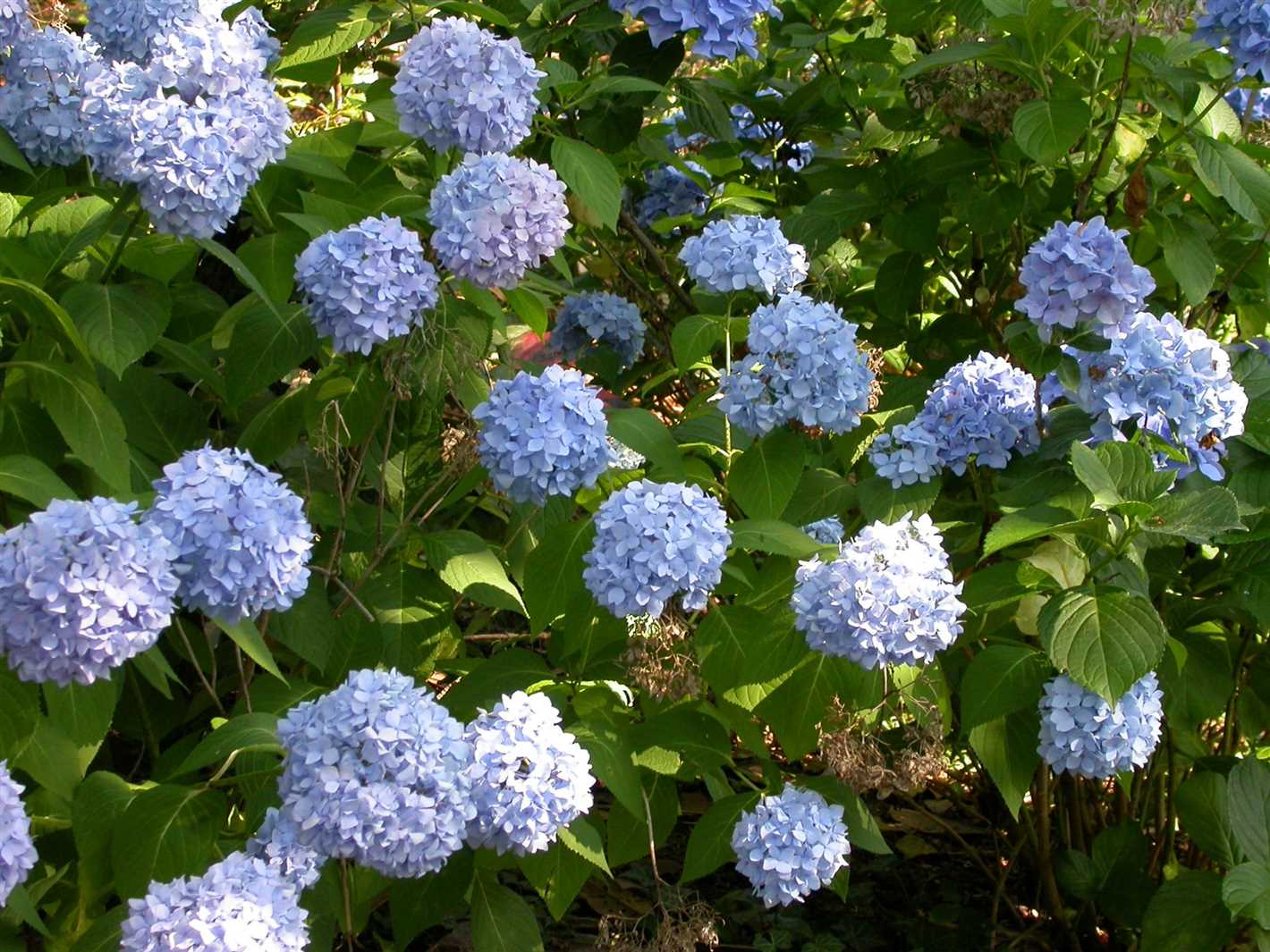
Consider using organic pest control methods to protect your hydrangea. These include using companion plants, such as marigolds or garlic, to deter pests. Additionally, you can use natural sprays, such as neem oil or insecticidal soap, to control pests.
5. Use disease-resistant varieties
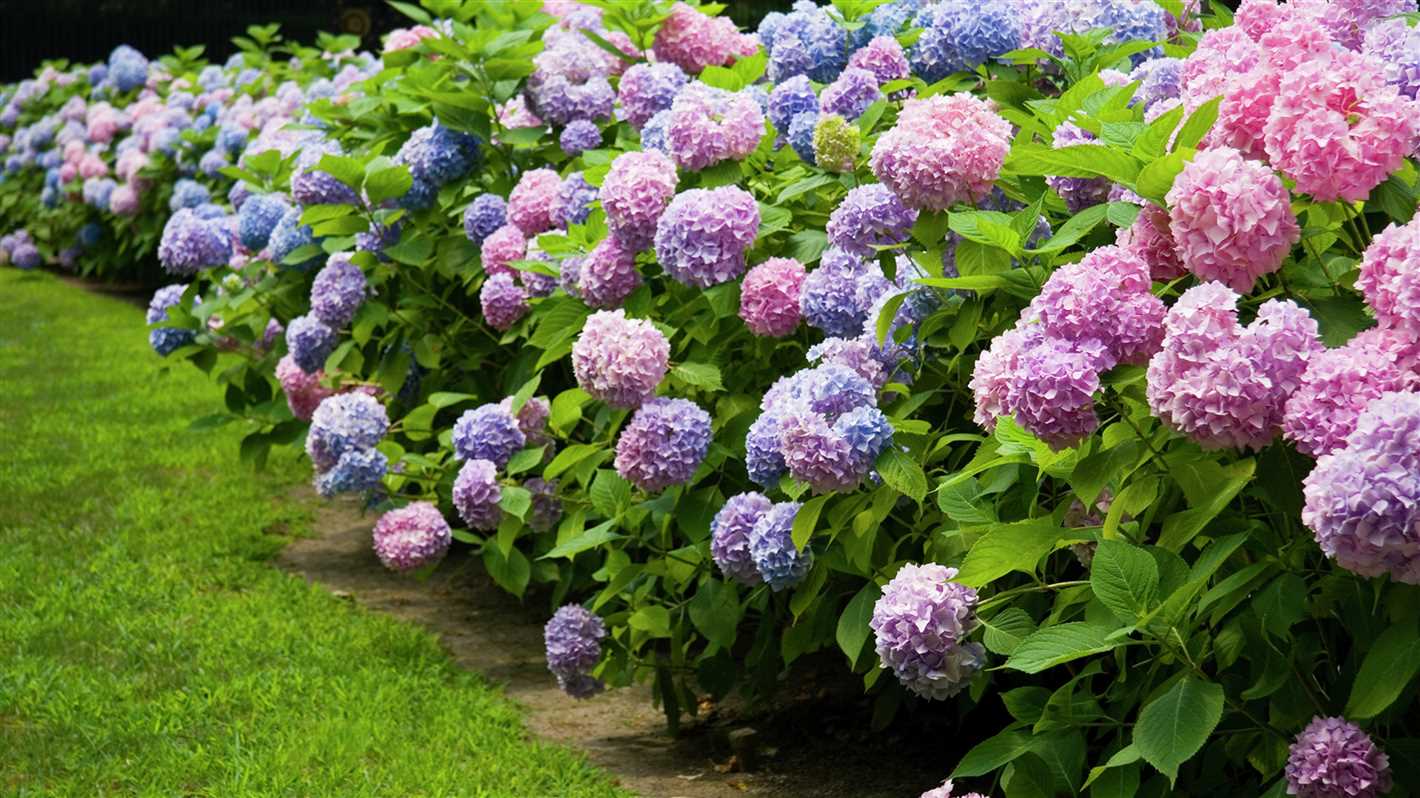
Opt for disease-resistant varieties of large-leaved hydrangea. These varieties are bred to be more resistant to common diseases and may require less maintenance and protection.
6. Provide proper watering and fertilization
Avoid overwatering your hydrangea, as it can create conditions favorable for disease development. Water your plant at the base to keep the foliage dry. Additionally, provide the plant with proper nutrients through regular fertilization to keep it healthy and less susceptible to diseases.
7. Mulch around the base
Apply a layer of organic mulch around the base of your hydrangea. Mulching helps retain moisture in the soil, suppresses weed growth, and acts as a barrier against pests. However, make sure not to pile mulch directly against the stem, as it can promote rotting.
8. Clean gardening tools
Keep your gardening tools clean and sanitized to prevent the transfer of pests and diseases. Disinfect your tools after each use with a solution of bleach and water or rubbing alcohol.
By following these tips, you can protect your large-leaved hydrangea from common pests and diseases, ensuring its health and longevity.
Ensuring its survival during winter
When it comes to ensuring the survival of your large-leaved hydrangea during winter, there are a few key steps you can take:
1. Provide winter protection
Large-leaved hydrangeas are not particularly frost-hardy, so it’s important to provide protection during the winter months. One way to do this is by mulching around the base of the plant with a thick layer of organic matter, such as wood chips or straw. This will help to insulate the roots and prevent them from freezing.
2. Avoid pruning in late summer or fall
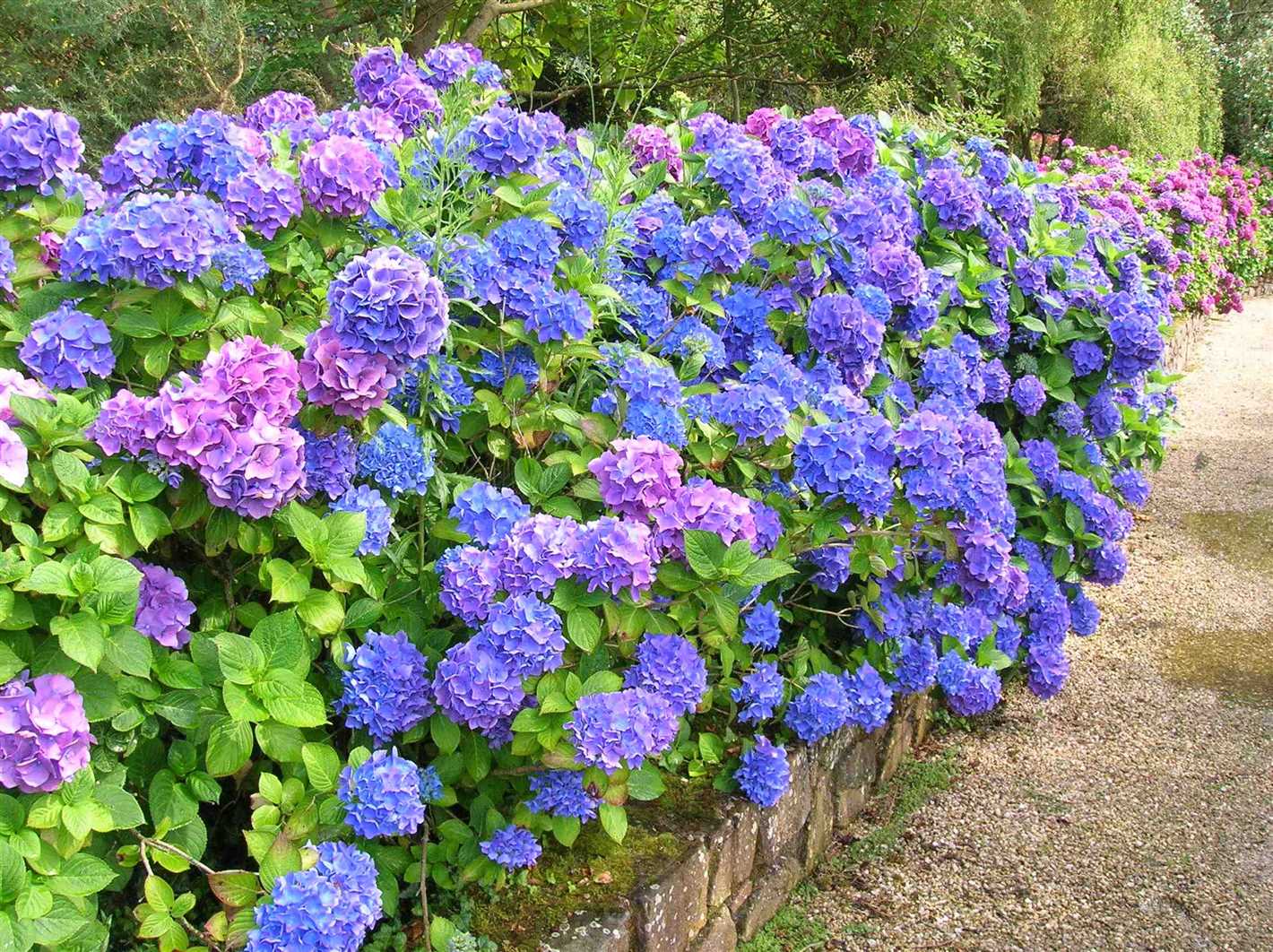
It’s best to avoid pruning your large-leaved hydrangea in late summer or fall, as this can stimulate new growth that may be more susceptible to winter damage. Instead, wait until early spring to prune any dead or damaged branches.
3. Consider using a frost cover
If you live in an area with particularly harsh winters, you may want to consider using a frost cover to protect your hydrangea from extreme cold and drying winds. These covers can be placed over the plant and secured with stakes or rocks.
4. Water sparingly
During the winter months, it’s important to water your large-leaved hydrangea sparingly. Overwatering can lead to root rot, while underwatering can cause dehydration. Aim to keep the soil evenly moist, but not soaked.
5. Monitor for signs of stress
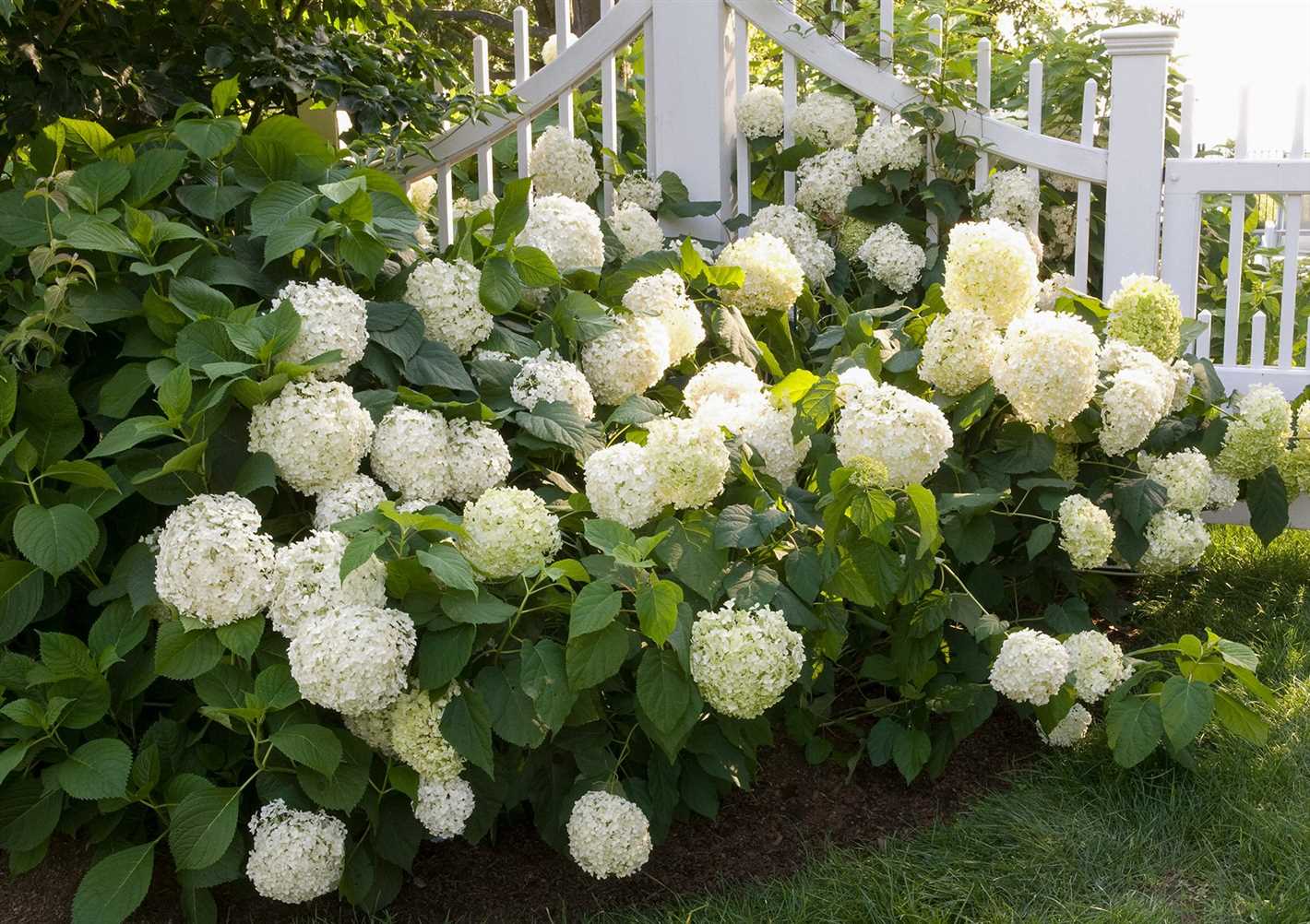
Throughout the winter, keep an eye out for any signs of stress or damage, such as wilting or browning leaves. If you notice any issues, take immediate action to remedy the problem, such as adding mulch or providing additional protection.
By following these tips, you can help ensure the survival of your large-leaved hydrangea during the winter months, so it can continue to thrive and provide beautiful blooms in the spring and summer.
Harvesting and drying the blooms
Harvesting the blooms:
When the hydrangea blooms are fully developed and mature, it is time to harvest them for drying. The best time to harvest the blooms is in the morning when the weather is cool and the plants are hydrated. Here are the steps to follow:
- Prepare a clean pair of garden shears or scissors.
- Select the blooms that are fully open and have vibrant colors.
- Cut each stem about 12-18 inches below the bloom, making sure to leave a long stem.
- Place the harvested blooms in a bucket or vase with clean water immediately after cutting to prevent wilting.
Drying the blooms:
Once the blooms have been harvested, it’s time to dry them to preserve their beauty and extend their lifespan. Here are a few methods for drying hydrangea blooms:
- Air drying: Remove any excess leaves from the stems and gather a few stems together. Tie the stems together with a string or rubber band and hang them upside down in a dry, well-ventilated area. The blooms will take several weeks to dry completely.
- Silica gel: Fill a container with silica gel, a drying agent available at craft stores or online. Place the hydrangea blooms carefully in the container, making sure they are not touching each other or the sides of the container. Cover the blooms completely with more silica gel, making sure they are fully submerged. Seal the container and leave it undisturbed for several days until the blooms are completely dry.
- Pressing: For a flattened and preserved appearance, you can press the hydrangea blooms. Place the blooms between two pieces of absorbent paper or in a flower press. Apply pressure by placing weights or heavy books on top. The blooms will take a few weeks to dry and flatten completely.
Storing the dried blooms:
Once the hydrangea blooms are fully dried, they can be stored in airtight containers or used immediately in crafts, floral arrangements, or as decoration. Keep the dried blooms in a cool, dry place away from direct sunlight to ensure their longevity.
Questions and Answers:
What are some essential tips for growing large-leaved hydrangea outdoors?
Some essential tips for growing large-leaved hydrangea outdoors include providing them with the right amount of sunlight, watering them regularly, and fertilizing them during the growing season.
How much sunlight does a large-leaved hydrangea need?
A large-leaved hydrangea needs at least 4-6 hours of direct sunlight per day. However, in hot climates, it is best to provide them with partial shade to protect them from the intense heat.
What is the best way to water a large-leaved hydrangea?
The best way to water a large-leaved hydrangea is to provide them with deep watering once a week. Make sure the soil is well-draining and avoid overwatering, as it can lead to root rot.
When should I fertilize a large-leaved hydrangea?
You should fertilize a large-leaved hydrangea during the growing season, which is typically from spring to early fall. Use a balanced slow-release fertilizer or a specific hydrangea fertilizer according to the instructions provided.
How can I ensure the survival of a large-leaved hydrangea during winter?
To ensure the survival of a large-leaved hydrangea during winter, you can protect it by applying a layer of mulch around the base of the plant, wrapping it with burlap or protective covering, and avoiding pruning until spring.
Can I grow a large-leaved hydrangea in a container?
Yes, you can grow a large-leaved hydrangea in a container. Choose a container that is at least 18 inches in diameter, use a well-draining soil mix, and provide regular watering and fertilizing for optimal growth.







